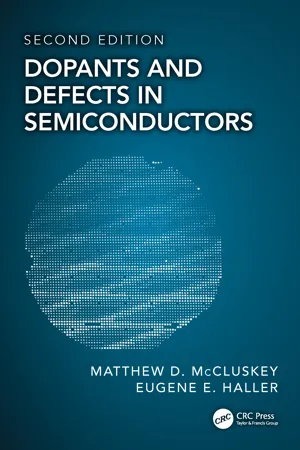
- 350 pages
- English
- ePUB (mobile friendly)
- Available on iOS & Android
Dopants and Defects in Semiconductors
About This Book
Praise for the First Edition
"The book goes beyond the usual textbook in that it provides more specific examples of real-world defect physics … an easy reading, broad introductory overview of the field"
? Materials Today
"… well written, with clear, lucid explanations …"
?Chemistry World
This revised edition provides the most complete, up-to-date coverage of the fundamental knowledge of semiconductors, including a new chapter that expands on the latest technology and applications of semiconductors. In addition to inclusion of additional chapter problems and worked examples, it provides more detail on solid-state lighting (LEDs and laser diodes). The authors have achieved a unified overview of dopants and defects, offering a solid foundation for experimental methods and the theory of defects in semiconductors.
Matthew D. McCluskey is a professor in the Department of Physics and Astronomy and Materials Science Program at Washington State University (WSU), Pullman, Washington. He received a Physics Ph.D. from the University of California (UC), Berkeley.
Eugene E. Haller is a professor emeritus at the University of California, Berkeley, and a member of the National Academy of Engineering. He received a Ph.D. in Solid State and Applied Physics from the University of Basel, Switzerland.
Frequently asked questions
Information
Table of contents
- Cover
- Half Title
- Title Page
- Copyright Page
- Dedication
- Contents
- Preface to the Second Edition
- Preface to the First Edition
- Authors
- Abbreviations
- List of Elements by Symbol
- Chapter 1: Semiconductor Basics
- Chapter 2: Defect Classifications
- Chapter 3: Interfaces and Devices
- Chapter 4: Crystal Growth and Doping
- Chapter 5: Electronic Properties
- Chapter 6: Vibrational Properties
- Chapter 7: Optical Properties
- Chapter 8: Thermal Properties
- Chapter 9: Electrical Measurements
- Chapter 10: Optical Spectroscopy
- Chapter 11: Particle-Beam Methods
- Chapter 12: Microscopy and Structural Characterization
- Appendices
- Physical Constants
- Index